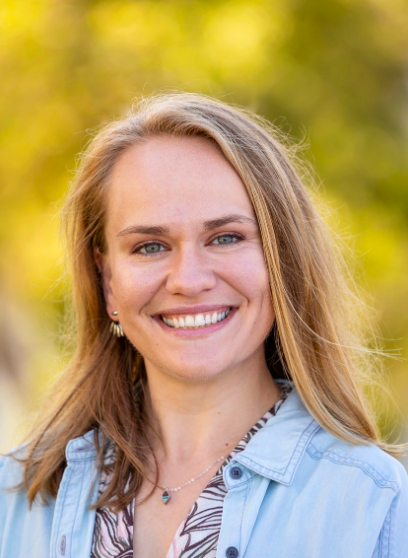INTERVIEW: ‘Changing Planet’ has returned, this time with an ecohydrologist
Photo: Dr. Emily Fairfax releases a beaver into the wilds of Northern California on Changing Planet. Photo courtesy of Mary Melville/BBC Studios / Provided by press agent with permission.
Changing Planet, the documentary series on PBS, has returned for second two-part feature that explores how Earth today is different than yesterday and almost certainly will be different from tomorrow. Specifically, the Dr. M. Sanjayan-hosted show delves into vulnerable ecosystems that are facing uncertain futures due to climate change. This time around, the series heads to Brazil, Kenya, California and everywhere in between.
One of the voices in this second special is Dr. Emily Fairfax, an assistant professor of physical geography in the department of geography, environment and society at the University of Minnesota Twin Cities, according to her official biography. Her specialty is ecohydrology and specifically looking at beaver populations. She has identified and mapped beaver dams and channels, according to press notes, and she has learned that their aquatic abodes may actually help protect against wildfires.
Recently Hollywood Soapbox exchanged emails with Fairfax, who is featured on Changing Planet. For those who missed the April 19 premiere, the show is streaming through May 17 on PBS.org and on the PBS app. Questions and answers have been slightly edited for style.
For the layperson, could you describe what an ecohydrologist studies?
Ecohydrologists are like a blend of hydrologists that study water, and ecologists that study plants and animals. Generally speaking, ecohydrologists study how living things impact the water cycle — or vice versa — how the water cycle impacts living things. In my work as an ecohydrologist, I study how beavers change the way that water moves through landscapes.
How important are beavers to the environment?
Beavers are incredibly important in all the places they’re native to, which is most of North America and much of Eurasia. They are both an ecosystem engineer and a keystone species. Being an ecosystem engineer means an animal is capable of physically reshaping its environment to better suit its own needs. In the case of beavers, that’s transforming streams into wetlands. Beaver dams help slow water down and keep it on the landscape longer. When their dams slow water down, some of it gets stored in the soil where plant roots can access it even during drought. That helps keep vegetation wet and lush, so that when wildfires do start, the beaver complexes are particularly resistant to burning. These fire-resistant patches help preserve intact ecosystems, provide refuge to animals that cannot outrun/fly/swim the fire, stabilize river banks post-fire, and help catch and settle out ash and sediment that is suspended in the streams post-fire.
The reason that beavers are also a keystone species is that these disturbance-resistant, beaver-built wetlands are critical habitat for many other plants and animals. Without the wetlands, those other organisms cannot survive, and in many places the wetlands wouldn’t be there if not for the beavers — so those organisms rely on beavers to make and maintain the wetland habitat that they need.
Are beavers building dams ever destructive to the environment?
Within their native habitats, beavers and their dams are not a problem. Beavers have been damming and extensively modifying this continent for about 7 million years — any species that were not able to coexist with them would already have gone extinct by now. The fish that run the streams beavers dam are able to easily swim over, under, through or around their dams depending on where they’re at in their lifecycle. The beaver’s preferred species of trees to chew on and cut down are usually able to regrow quickly from the stump by putting out new shoots, or even clone itself from the cutting the beavers take away and build with.
Willow, for example, is a favorite of beavers, and when beavers cut off a willow branch and use it as building material for their dams, that willow branch can resprout and put out roots and become a whole new willow plant right there on the dam. Beavers don’t eat fish; they’re territorial, so they don’t overcrowd rivers. And they are no more likely to spread disease than any other mammal. When we hear about “destructive” beaver dams, that is usually in the context of beavers damming a location where we (people) have built roads or houses on, and the beaver pond is flooding them. We just need to remember that the flooding is a great thing from the perspective of the beaver and the fish and the plants and the rest of the ecosystem. It’s just not great from our perspective because we don’t want our infrastructure underwater.
What do you believe is the value of programs like Changing Planet?
Programs like Changing Planet are really valuable for a couple reasons. First, we don’t always realize the different challenges and changes happening around the world due to climate change. Seeing them with our own eyes — even if on a TV or computer screen — really helps put the scale of climate change into perspective. Second, a lot of the media around climate change is really grim, which makes sense because climate change is grim. But, we still need to have hope and feel inspired to do something about it because it’s not too late. We need to see examples of everyday people making a difference in their local communities, of animals like beavers being our allies and helping in the fight against wildfire, of the depth and breadth of Indigenous knowledge around the world that is crucial for understanding how to live as part of the planet rather than just trying to control it. We need to see proof that individual people — and beavers — can make a real difference in our collective effort to deal with climate change. Programs like Changing Planet let us see that.
Has climate change impacted beaver populations?
Beavers are really unique in how well they can adapt to different climates — beavers live in the deserts, mountains, coasts, scorching hot places, freezing cold places, forests, grasslands, urban areas — you name it. If it has free-flowing water and some tasty vegetation, beavers can probably turn it into their home. Once they’ve established themselves somewhere, they’re able to stick it out through droughts, fires and floods. So in that sense, they’re pretty climate-change-resistant themselves.
But they are not completely immune to the effects of climate change — in some areas the vegetation communities are shifting to be less ideal for beavers, and that reduces the number of beavers that can live in a given area. In other areas — like the Arctic — permafrost is rapidly thawing and previously frozen landscapes are turning into shrubby ecosystems, which is great beaver habitat.
Beavers are a climate-tracking species, meaning they are capable of quickly following climate-change-driven ecosystem shifts. In this case, that means they’re moving north to take advantage of the newly thawed, shrubby landscapes. Their range expansion is complicated though because there is evidence that large beaver dams can locally accelerate permafrost thaw (which is generally not good), but there is also evidence that their wetlands in the Arctic are major hotspots of biodiversity, excellent habitat for threatened fishes, and provide year-round food sources to local communities (which is generally good). Figuring out how to best coexist with beavers across their entire modern range, including in the more challenging places like cities and in the Arctic, is extraordinarily important if we want to continue to benefit from the climate resilience they create.
By John Soltes / Publisher / John@HollywoodSoapbox.com
Changing Planet, featuring Dr. Emily Fairfax, is now available to stream on PBS.org and on the PBS app. Click here for more information.


